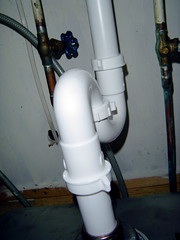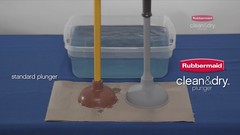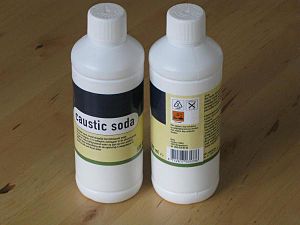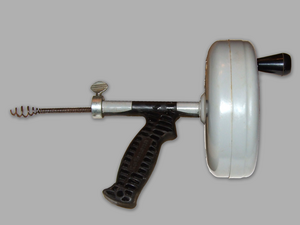During the past few weeks I have shown you how to slay the "Thing in the Bathtub." I have also demonstrated how to safely and effectively clear a clogged kitchen sink. But the one thing I haven't shown you is how to maintain the bathroom sink. Just like the kitchen sink, the reason that the one in the bathroom gets gunked up has to do with diet. Whereas the kitchen sink is forced to eat everything from vegetable peels to chicken fat (neither of which are good for the disposal), the bathroom sink has to contend with everything from shave cream and toothpaste to hair. With a diet like that it isn't unusual for the bathroom sink to get a case of indigestion and slow to a crawl or even stop up altogether. If that should happen to you, do not panic. Because I will show you how to clear most drain problems without having to call yours truly, the plumber.
How to Avoid Pain in the Drain
 |
| plumbing, too (Photo credit: found_drama) |
The good news is that nine times out of ten, the clog will reside with the Popup Assembly, which is the connection under the sink that lets you open and close the drain. Located justabove the P-Trap, the Popup Assembly is a natural gathering point for hair. By disassembling the assembly (see video below), you will be able to remove any hairballs that have begun to impede the smooth flow of water. Once finished, reassemble the trap and run hot water down the drain. If the sink continues to drain slowly, this means that the clog is located yet deeper down the drain.
At this point, many of you will probably reach for a bottle of drain cleaner. This would be a mistake. In the first place, as I have pointed out earlier blogs, most drain cleaners rely on corrosive compounds that are not only dangerous to handle, they also have a tendency to eat right through most pipes if used frequently enough. Take it from a plumber, this is not something that any professional would use to clear a clog. If you insist on using a liquid, try this homebrew first. It is guaranteed neither to eat your pipes nor send you to the ER if you splash some on yourself.
Recipe for homemade drain cleaner
1/2 cup baking soda
1 cup of vinegar
1/2 gallon of hot (not boiling) water
To start with, pour a half cup of dry baking soda into the drain opening. Next, pour one cup of vinegar on top of the soda and let this mixture do its thing for thirty minutes or so. Last but not least pour a half gallon of hot water into the drain. (If you bring the water to a boil you may melt your pipes if they are plastic.)
 |
| Consumer Reactions to the Rubbermaid Clean & Dry™ Plunger with NeverWet™ Superhydrophobic Nanotechnology (Photo credit: Rubbermaid Products) |
If the clog still refuses to budge, step three is to crawl beneath the sink and see if the P-Trap is to blame. Particularly if there are small children in the home, it is entirely possible that a toy or some other element that was never intended to go down the drain has become lodged in the sinuous confines of the P-Trap. Before taking a wrench to loosen the trap, make sure you place a basin or bucket directly underneath, since any water contained in the trap is going to come out. Once the trap is undone at both ends, remove it and turning it upside down, see if anything besides water comes out.
If the trap is clear, that means that the clog is located still further down the drain. If that's the case, then you need to click over to my blog, "Eliminating Pain in the Drain."
While there are some instances where you will need to call in a professional, when it comes to the care and feeding of your bathroom drain, the most important thing is to nip the problem in the bud by tackling a slow drain before it turns into a clogged drain. I routinely clear the popup assembly and run a sink full of hot water down the drain on a monthly basis to keep the pipes clear. With proper preventive maintenance, you too can keep your bathroom sink flowing freely and help avoid pain in the drain.
Billy Aldridge is one of the Doctors of Plumbology at Aldridge and Sons Plumbing in Jacksonville, Florida. Visit their site for more how-to blogs and videos as well as 24/7 service for all your plumbing Jacksonville FL needs. http://plumbing-jacksonville-fl.com






